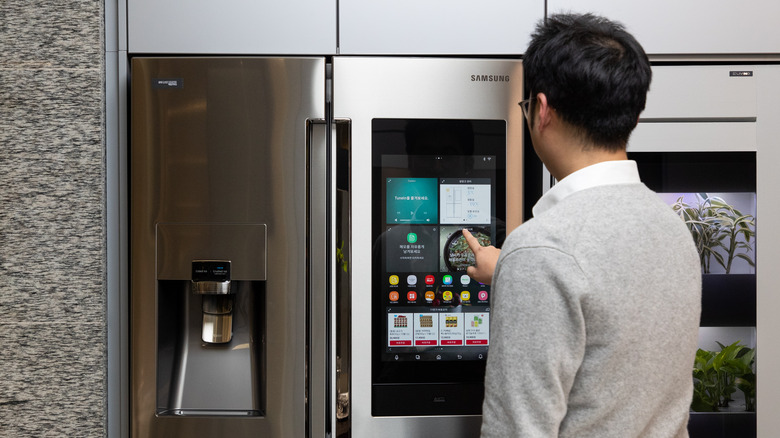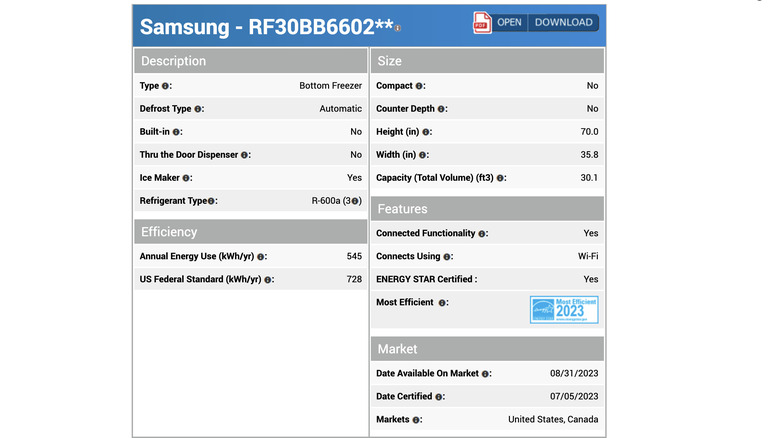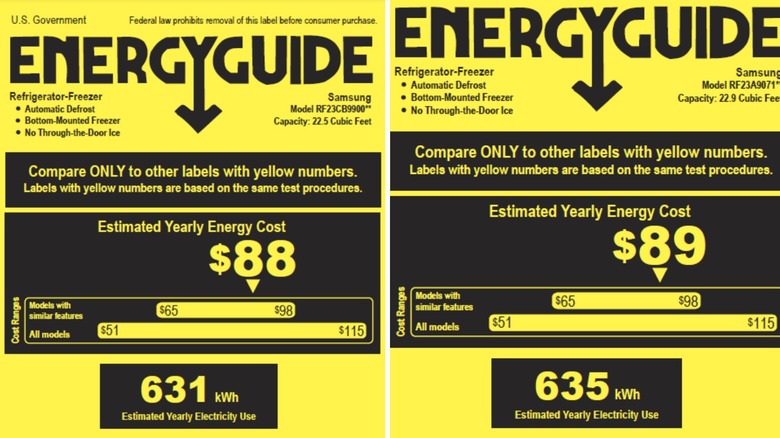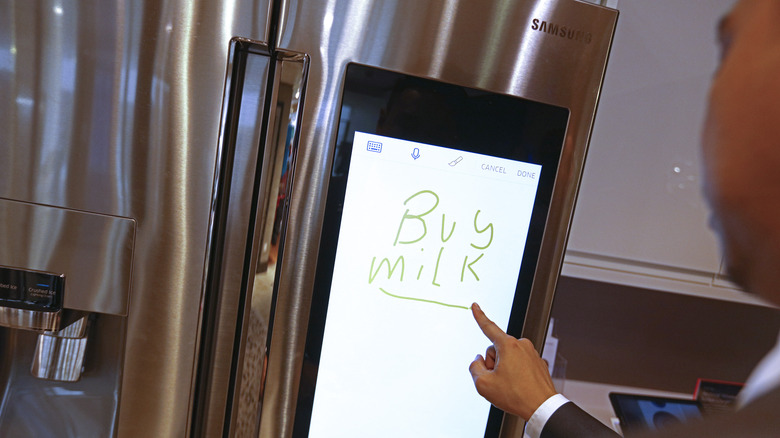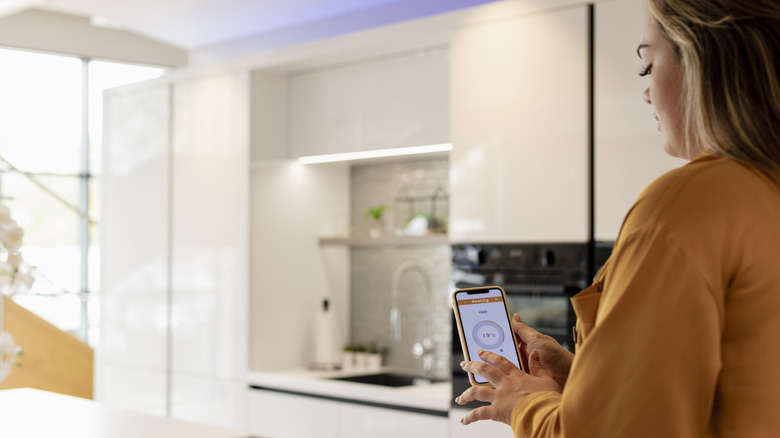Will A New Smart Fridge Really Save You Money On Your Electricity Bill?
Smart fridges are huge, fancy, and even have massive screens stuck to the front of them. They have ice and cold water dispensers and crazy flex areas that can switch between refrigerating and freezing. They're so outlandishly extravagant that it's only natural to question their energy and money-saving claims. Can adding so many features and even huge touch screens allow for better energy usage?
Luckily, there's plenty of information out there, thanks to federal laws and standards, that can help you figure out what's going on. Your most efficient tool in this endeavor is the Energy Star website, where you can find information on the thousands of fridge models available. Calculated according to U.S. Department of Energy test procedures, Energy Star shows the annual energy use in kilowatts per year for every fridge, along with the U.S. federal standard for models of that specific type and size. This information gives you an instant idea of the model's overall energy efficiency, so it's a great way to check and compare different fridges.
Instant red flags to look out for
Before you start researching a certain fridge model, there are a few red flags you can spot right on the product page that indicate higher energy use. The first is "through the door" dispensers. While ice and cold water dispensers on the front of a fridge door were all the rage a decade or so ago, you'll notice that a lot of the newest models no longer have them. This is because, while convenient, this feature increases energy use by quite a significant amount. According to Energy Star, they typically increase energy use by 14-20%.
Another thing to look out for is Energy Star certification. You'll see these as blue and white stickers on the fridge itself and the model's product page. On average, Energy Star-certified refrigerators are about 9% more energy efficient than the federal standard. However, just about any fridge can earn Energy Star certification, even if it's not a smart fridge, so it's not a great indication of whether the smart model will save you money or not. Instead, what you need to look for is the Star Energy Most Efficient sticker. These models offer the latest in energy efficiency and other technological innovations and are basically Energy Star's top recommendations.
One last thing to check is the type of refrigerant. The two lowest GWP (Global Warming Potential) refrigerants are R-600a and R-441A, so try to choose a model that uses one of these.
Make use of the EnergyGuide label
Another handy bit of information you can find for every fridge model is the EnergyGuide label. Manufacturers are compelled by law to display this label on their product pages so consumers can see the estimated yearly energy cost and electricity use of the fridge. The cost is compared with both models with similar features so you can get a broad idea of the model's efficiency and how much more efficiency you might be able to find elsewhere. The label also has the Energy Star certification sticker printed in the bottom right corner if the model has earned the certification.
The first thing you might want to try if you're thinking of buying a smart fridge is finding the EnergyGuide label for your current model or a non-smart model you're considering and comparing it to the smart fridges you're looking into. Smart fridges also use energy management systems to optimize their energy usage further, so this label won't work as a complete comparison. Still, you can at least see how the usual usage compares.
For example, the two EngeryGuide labels above show two Samsung fridge models: one smart model (left) with a "Family Hub" touch screen and access to the SmartThings Energy app, and the other (right) is basically the same but without the smart features. As you can see, even without the potential savings from the SmartThings Energy app, the smart fridge is ever so slightly more efficient than the normal fridge.
Saving money and energy with management apps
One of the most popular brands of smart fridges is Samsung, and Samsung also offers its own energy management services called SmartThings. Multiple fridge models work with SmartThings, even ones without touch screens — but they can only do limited things like send notifications when the door is left open or when the water filter needs changing.
For smart fridges, you can activate SmartThings Energy in the SmartThings app to access a number of features that can help you avoid wasting energy. The service as a whole is known as a Smart Home Energy Management System (SHEMS), and SmartThings is the first of its kind to earn an Energy Star certification. While the platform can only promise potential savings due to the variations in results caused by individual circumstances, this certification at least shows that the U.S. Environmental Protection Agency believes the service has a positive impact on the environment.
The app allows you to turn off appliances from anywhere and send notifications if something is left on when no one is in the house. It can also create schedules to sync energy-intensive activities with off-peak hours and lower power usage at peak times. All of this happens automatically once you set things up, but you can also track everything in real time to see if it's all working as you want and meeting the energy goals you've set for yourself.
So... will it help or not?
The bottom line is always it depends on where you are and your individual circumstances. How many people are in your house, how often the fridge is opened, what you put in your fridge, what energy prices are like in your area — all of this affects how much energy you use. One cold truth is that saving energy does take daily effort; it's not just automatic once you've bought the fancy fridge. The more ice you use, the more energy you use, and if you frequently put warm or hot food in the fridge, you'll use more energy to cool it. Changing habits like these is as important as using a SHEMS (Smart Home Energy Management System) to optimize energy usage. If you are willing to go all out, though, the energy-tracking features of services like SmartThings will definitely help you optimize your efforts.
One other thing to consider is repair costs. If you're interested in saving energy for the sake of the environment, this isn't too much of a deal breaker, but if you're aiming to save money for financial reasons, it might be a different story. With more features and more things that can go wrong, repairs can be more frequent than with your current fridge — especially if your current one also lacks features like ice machines and drink dispensers as well. With a bit of bad luck, your monthly energy savings could be completely canceled out by repair costs.
